
Thursday August 10, 2023

The UN World Food Program (WFP) said that some 76.7 million people were food insecure in Eastern Africa as of early July, a decrease compared to the lean season in 2022.
The WFP, however, said in its situation report released Tuesday evening that the number is still extremely high compared to 2021 and 2020.
"The impacts of the 2020-2023 drought are likely to persist for a long time as livelihoods were destroyed and 23.4 million people have left food insecure in drought-affected areas," the WFP said.
This, it said, is despite the improved rains during the March to May 2023 season and the forecasted El Nino event for the end of 2023.
The WFP said food insecurity levels across the region are likely to remain high through the second half of 2023, particularly as this is the lean season for many areas.
It warned international dynamics such as global macroeconomic trends will continue to have an impact but food insecurity levels are likely to be slightly lower than the peak in 2022 due to the decrease in the impact of the conflict in Ukraine and the COVID-19 pandemic.
"While there has been rainfall in drought-affected areas of the Horn of Africa, food insecurity levels are likely to continue to be extremely high as any improvement with rains in drought-affected land will be slow," the WFP said.
It said the effects of the severe drought in Kenya's arid and semi-arid lands (ASALs) continued to have repercussions on the food insecurity levels in the first half of 2023.
An estimated 5.4 million people were projected to be food insecure between March and June 2023, the WFP said.
In Somalia, the UN agency said the food security situation remains dire but has improved since the scale-up of humanitarian assistance in 2022.
"As of the end of June, an estimated 6.5 million people are projected to be acutely food insecure," the WFP said.
Some 7.4 million people in South Sudan are projected to be food insecure, 63 percent of the population due to conflict and insecurity, macroeconomic challenges, and climatic concerns such as prolonged floods, it said.
According to the WFP, some 20.3 million people are projected to be food insecure in Sudan due to the continuation of conflict since mid-April and an already difficult economic situation.
In Ethiopia, an estimated 20.1 million people were food insecure due to severe drought and conflict-related shocks, according to the WFP.
The World Meteorological Organization El Nino-Southern Oscillation June update indicates a 90 percent probability of El Nino conditions over the July-September period.
According to the WFP, a simultaneous El Nino event and Indian Ocean Dipole (IOD) in the region normally depresses the June-September rainfall in the north but enhances the short rains in equatorial areas.
This, it said, is likely to improve food security in the Horn of Africa by improving water availability for crop production and livestock.
"It will likely decrease the possibility of massive flooding in Sudan and South Sudan but increase the chance of localized flooding in the Horn of Africa," the WFP said.